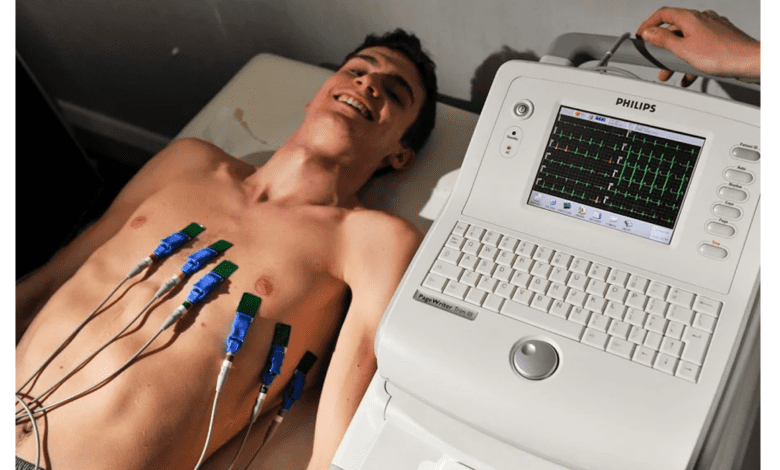Resting ECG: Unveiling the Secrets of Your Heart’s Rhythm

The human heart, with its intricate dance of rhythms and beats, holds the key to our overall well-being. To understand and monitor these rhythms, healthcare professionals often turn to a diagnostic tool known as the Electrocardiogram (ECG). In this article, we will delve into a specific aspect of ECG — the Resting ECG — exploring its significance, procedure, benefits, technological advancements, challenges, and future trends.
I. Introduction
A. Definition of Resting ECG
Resting ECG, short for Resting Electrocardiogram, is a non-invasive medical test that records the electrical activity of the heart while the patient is at rest. Unlike other ECG variations, resting ECG provides a baseline measurement, offering valuable insights into the heart’s functionality.
B. Importance of Resting ECG in Healthcare
Resting ECG plays a pivotal role in preventive medicine, allowing healthcare professionals to assess the heart’s electrical patterns and identify potential issues before they escalate. This diagnostic tool has become a standard procedure in routine health check-ups, aiding in the early detection of cardiovascular problems.
II. Understanding Resting ECG
A. Electrocardiogram Explained
Before we delve into the specifics of Resting ECG, let’s grasp the fundamentals of an Electrocardiogram. An ECG measures the electrical impulses generated by the heart, translating them into a visual representation. This invaluable tool assists in diagnosing various heart conditions and irregularities.
B. Purpose of Resting ECG
The primary purpose of Resting ECG is to assess the heart’s activity when the body is at rest. This baseline measurement provides crucial information about the heart’s rhythm, identifying any abnormalities or potential risks.
C. How Resting ECG Works
During a Resting ECG, electrodes are strategically placed on the patient’s chest, arms, and legs. These electrodes detect the electrical signals produced by the heart, which are then recorded on a graph. The resulting waveform, commonly known as an ECG strip, provides a visual representation of the heart’s electrical activity.
III. Procedure and Preparation
A. Patient Preparation
To ensure accurate results, patients undergoing a Resting ECG are advised to avoid caffeine and certain medications that may interfere with the test. It’s crucial for patients to communicate any relevant medical history or concerns with the healthcare professional conducting the procedure.
B. Electrode Placement
Proper placement of electrodes is essential for an accurate reading. The healthcare provider will strategically position the electrodes on specific areas of the chest, arms, and legs, creating a comprehensive map of the heart’s electrical signals.
C. Duration of the Test
A Resting ECG is a relatively quick procedure, typically lasting around 5 to 10 minutes. The patient lies down while the machine records the heart’s electrical activity, capturing vital information for analysis.
IV. Interpretation of Results
A. Normal vs. Abnormal Results
Interpreting the results of a Resting ECG involves distinguishing between normal and abnormal patterns. A normal ECG indicates a healthy heart rhythm, while abnormal patterns may suggest various cardiovascular issues, such as arrhythmias or ischemia.
B. Common Issues Detected
Resting ECG is instrumental in detecting a range of heart-related issues, including atrial fibrillation, myocardial infarction, and other abnormalities that may compromise cardiovascular health.
C. Consultation with Healthcare Professionals
While the results of a Resting ECG provide valuable insights, it’s crucial to consult with healthcare professionals for accurate diagnosis and appropriate intervention if necessary. The expertise of cardiologists and other specialists ensures a comprehensive understanding of the patient’s heart health.
V. Benefits of Resting ECG
A. Early Detection of Cardiovascular Issues
One of the primary benefits of Resting ECG is its ability to detect cardiovascular issues at an early stage. Early intervention significantly improves the chances of successful treatment and prevents further complications.
B. Monitoring Heart Health
For individuals with known heart conditions or risk factors, regular Resting ECGs serve as a proactive measure to monitor heart health. This ongoing surveillance allows healthcare professionals to make timely adjustments to treatment plans or recommend lifestyle changes.
C. Integrating Resting ECG in Routine Check-ups
As technology advances, Resting ECG is becoming more accessible and integrated into routine health check-ups. This proactive approach to cardiovascular health exemplifies the shift towards preventive medicine, promoting overall well-being.
VI. Advancements in Resting ECG Technology
A. Wearable ECG Devices
The advent of wearable ECG devices has revolutionized how we monitor heart health. These portable devices allow individuals to record ECG readings at home, providing real-time data to healthcare professionals for analysis.
B. Mobile Apps for Monitoring
Mobile apps equipped with ECG monitoring features empower individuals to take an active role in their heart health. These apps often sync with wearable devices, creating a seamless ecosystem for tracking and analyzing ECG data.
C. Telemedicine and Resting ECG
The integration of Resting ECG into telemedicine platforms enhances accessibility. Patients can now undergo a Resting ECG from the comfort of their homes, with healthcare professionals remotely reviewing the results and providing guidance.
VII. Challenges and Limitations
A. False Positives and Negatives
Like any diagnostic tool, Resting ECG has its limitations. False positives and negatives can occur, necessitating further tests or clinical assessments to confirm or rule out potential issues.
B. Patient Compliance
Ensuring patient compliance with the preparation guidelines is a challenge. Patients may overlook dietary restrictions or fail to disclose relevant information, impacting the accuracy of the test results.
C. Accessibility and Affordability
While technology has improved accessibility, disparities still exist in the availability of Resting ECG services. Affordability remains a concern, especially for individuals without comprehensive healthcare coverage.
VIII. Future Trends
A. AI Integration in Resting ECG
The integration of artificial intelligence (AI) in Resting ECG analysis holds promise for more accurate and efficient diagnostics. AI algorithms can quickly analyze vast amounts of data, improving the detection of subtle abnormalities.
B. Continuous Monitoring Innovations
The future of Resting ECG lies in continuous monitoring. Wearable devices equipped with continuous ECG monitoring capabilities enable a more comprehensive understanding of heart rhythms over extended periods, providing valuable data for early detection.
C. Personalized Healthcare Solutions
Advancements in Resting ECG technology will pave the way for personalized healthcare solutions. Tailored treatment plans based on an individual’s unique ECG patterns and health history will become increasingly common.
IX. Suggest a Title
“Unveiling the Heart’s Symphony: The Significance of Resting ECG in Preventive Healthcare”
X. Conclusion
In conclusion, Resting ECG stands as a cornerstone in the realm of preventive healthcare, offering a window into the intricate rhythms of the heart. From its traditional roots to the latest technological advancements, Resting ECG continues to play a crucial role in early detection and monitoring of cardiovascular issues. As we embrace the future of healthcare, marked by AI integration and continuous monitoring, the significance of Resting ECG in promoting heart health remains unwavering.




